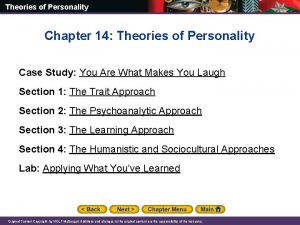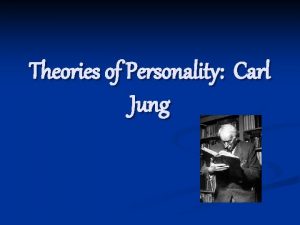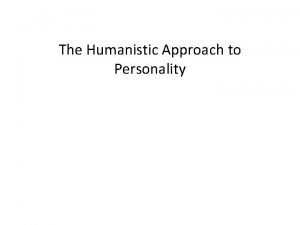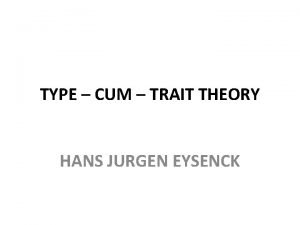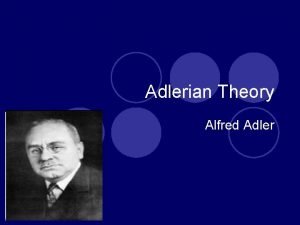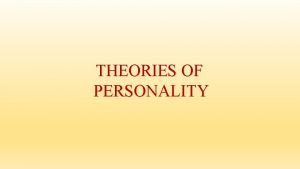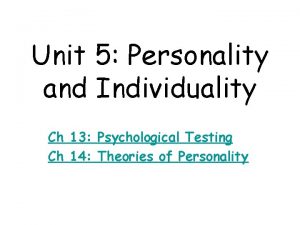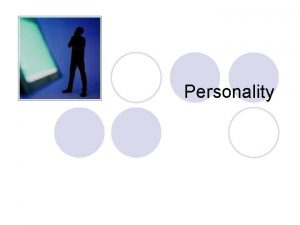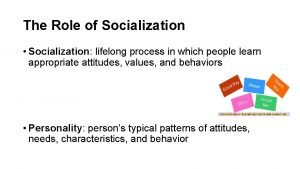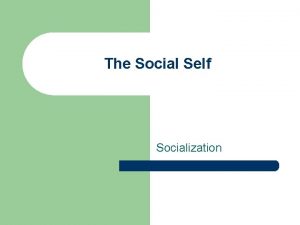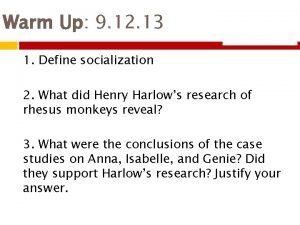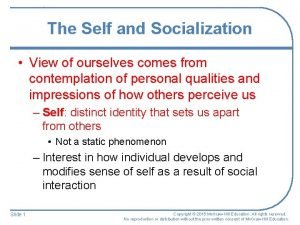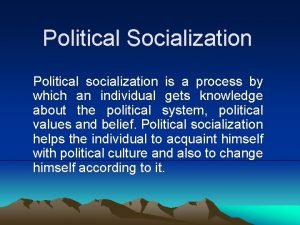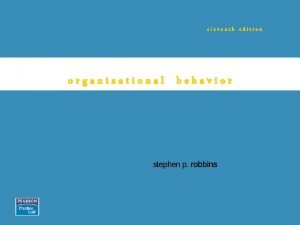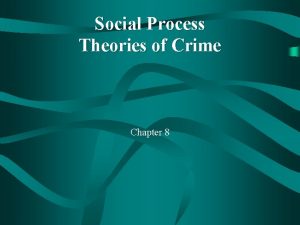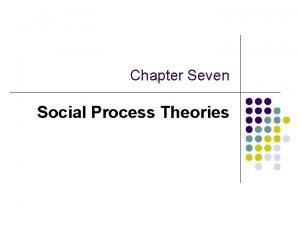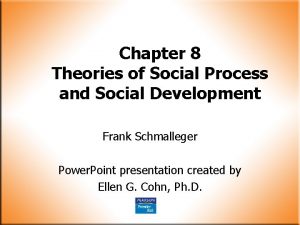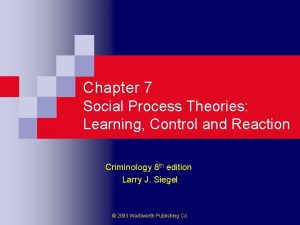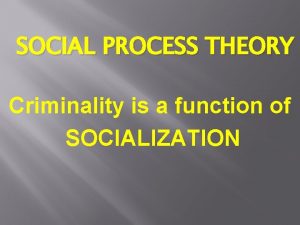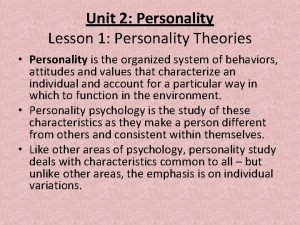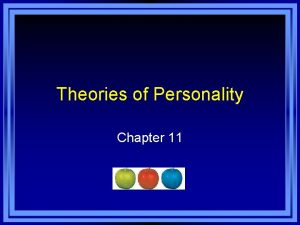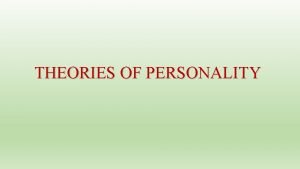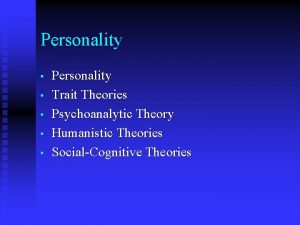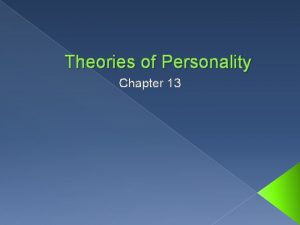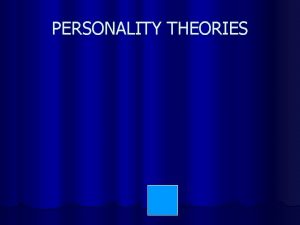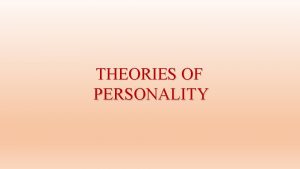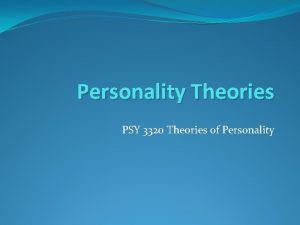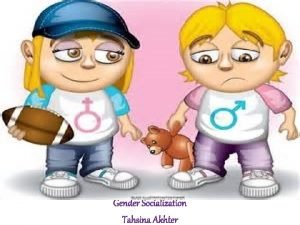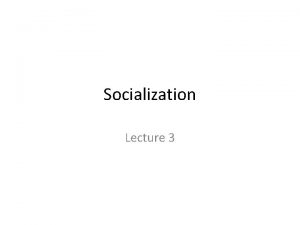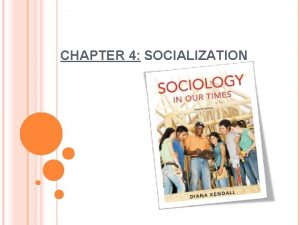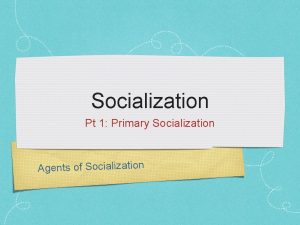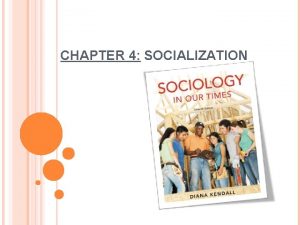THEORIES OF PERSONALITY Socialization Socialization The process of
























- Slides: 24

THEORIES OF PERSONALITY Socialization

Socialization • The process of learning to behave in a way that is acceptable to society.

Clean Slate • John Locke-born a tabula rasa (clean slate) • We are born w/out a personality • You can shape a newborn infant into whatever type of person you want

Socialization into the Self and Mind • How do you develop your SELF? • Unique human capacity of being able to see ourselves “from outside”

The Looking Glass (life long process) • Charles Cooley • Sense of self develops from interaction w/others • Looking Glass Self-process of developing the image of ourselves based on how we imagine we appear to others

The Looking Glass (life long process) • 3 Step Process • Imagine how we appear to others • Determine whether others view us as we view ourselves • Perception how others judge us

Mead and Role Taking • George Mead • We learn to take the role of the other • Role-taking-allows us to anticipate what others expect of us • Children must develop the necessary skills through social interaction

3 Stages of Learning • Imitation • Children under 3 mimic others. Do not have sense of self • Play • Ages 3 -6 • Pretend to take roles of specific people. • Games • Early School Years • Organized play or team games

Jean Piaget and the Development of Reasoning • Children go through a natural process of reasoning • How do we learn to Reason? • Sensorimotor Stage • Preoperational Stage • Concrete Operational Stage • Formal Operational Stage


Sigmund Freud • Personality came from 3 elements • Each child is born with an id • Pleasure seeking, self-gratification, demands attention To satisfy others needs, the ego develops Balances the force between the id and the demands of society that suppress it. Superego balances id and ego--conscience

Freud • Psychoanalysis-treatment of emotional problems through long-term, intensive exploration of the subconscious mind

Lawerence Kohlberg’s Theory • Through a sequence of stages we develop morality. • Amoral Stage-no right or wrong • Preconventional Stage-7 -10, learned rules and stay out of trouble • Conventional Stage-Age 10 -follow norms and values they learned • Postconventional Stage-People reflect on abstract principles of right and wrong (MOST PEOPLE DO NOT REACH THIS STAGE)


Agents of Socialization • The specific individuals, groups, and institutions that provide the situations in which socialization can occur • • Family Neighborhood Religion Day Care School Peer Groups Workplace Media

Socialization into Gender • Learning society’s “gender map” the paths in life set up for us because we are male or female • Gender Socialization • Family • Peers • Mass media

The Family • Most important agent • Loving family makes happy well-adjusted child • Parental attention is very important • Bonding and encouragement • Household environment • Stimulates development • Social position • Race, religion, ethnicity, class © 2013 Pearson Education, Inc. All rights reserved.

© 2013 Pearson Education, Inc. All rights reserved.

Neighborhood • Some neighborhoods are better than others for children • Children form poor neighborhoods are more likely to get in trough w/the law, become pregnant, drop out, and have mental health problems • More affluent neighborhoods keep a closer eye on the children • Affluent neighborhoods have fewer transition families

Peer Groups • Developing sense of self that goes beyond the family • Either “conform or rejection” • Young and old attitudes and the “generation gap” • Peers often govern short-term goals while parents influence long-term plans. • Anticipatory socialization • Practice working toward gaining desired positions © 2013 Pearson Education, Inc. All rights reserved.

The School • Experience diversity • Racial and gender clustering • Hidden curriculum • Informal, covert lessons • First bureaucracy • Rules and schedule • Gender socialization begins • From grade school through college, gender-linked activities are encountered © 2013 Pearson Education, Inc. All rights reserved.

The Mass Media • Televisions in the United States • 98% of households have at least one TV. • Two-thirds of households have cable or satellite • Hours of viewing television • Average household = 7 hours per day • Almost half of individuals’ free time • Children average 5 ½ hours per day • Television, videotapes, video games © 2013 Pearson Education, Inc. All rights reserved.

© 2013 Pearson Education, Inc. All rights reserved.

Criticisms About Programming • Violence in mass media • Survey: 2/3 of TV contains violence; characters show no remorse & not punished • In 1997, the television industry adopted a rating system © 2013 Pearson Education, Inc. All rights reserved.
 What does the psychoanalytic approach to personality teach?
What does the psychoanalytic approach to personality teach? Carl jung theory of personality
Carl jung theory of personality Humanistic theories examples
Humanistic theories examples Quiz on freud's psychoanalytic theory
Quiz on freud's psychoanalytic theory Dogmatism in consumer behaviour
Dogmatism in consumer behaviour Cum
Cum Strengths and limitations of adlerian theory
Strengths and limitations of adlerian theory Eysenck dimensions of personality
Eysenck dimensions of personality Trait theories of personality _____.
Trait theories of personality _____. Theories of personality
Theories of personality The looking glass self examples
The looking glass self examples Socialisation is a lifelong process discuss
Socialisation is a lifelong process discuss Self socialization definition
Self socialization definition Socialization is a lifelong process justify the statement
Socialization is a lifelong process justify the statement Socialization process
Socialization process Political socialization definition
Political socialization definition Chapter 16 organizational culture
Chapter 16 organizational culture Is the lifelong process of social interaction
Is the lifelong process of social interaction Miller's focal concerns
Miller's focal concerns Primary vs secondary deviance
Primary vs secondary deviance Differential association example
Differential association example Social process theories
Social process theories Social process theories
Social process theories Hát kết hợp bộ gõ cơ thể
Hát kết hợp bộ gõ cơ thể Frameset trong html5
Frameset trong html5
